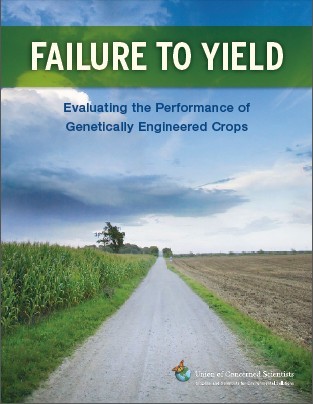Unbending Notes
一份来自美国科学家就转基因增产神话的调研报告
2012-04-16 14:04:14 来源:光明网卫生事业部
[译校注] 2009年3月,这份由美国麻省理工学院科学家组织的专家格里安. 谢尔曼撰写的题为《转基因未能兑现的产量----转基因作物的性能评价》报告公布后,引起了全球、特别是美国公众的强烈反应,很多美国人这时才发觉,自已近40年来一直都被转基因产业大享所忽悠,因为大家最初支持转基因农作物研发,特别是听到了他们曾经承诺了一些十分响亮口号,包括:“转基因能****限度地增产!” ,“转基因能解决全世界穷人的饥饿问题” 等等,我们把“科学家关注联盟”网站上的有关这份报告的介绍翻译出来,让有兴趣的朋友自己找出该报告去深入细读。我们也希望读者能把您的意见反馈给我们光明网卫生频道的同事,让我们共同关注全球转基因主粮的安全问题。小标题是译者所加。
一、《转基因未能兑现的产量》报告研究背景
多年来,转基因生物技术产业以标榜能养活整个世界大肆鼓墟,并声称转基因作物会产生更高的产量。
 |
由美国麻省理工学院科学家发起组织的“科学家关注联盟”专家格里安. 谢尔曼(Doug
Gurian-Sherman)先生在2009年3月发布了题为《转基因未能兑现的产量》报告,认为以上这些转基因生物技术产业一贯标榜的承诺都是空谈:他用了美国近20多年的数据研究和13年转基因商品化了的资料分析,证明基因工程并不能够显著增加美国农作物的产量。
《转基因未能兑现的产量》是以农作物的产量作为指标仔细评估基因工程的整体效果的第一份报告,对比转基因与其他农业科技差异。报告综述二十几份玉米和大豆的学术研究资料,它们都是种植在美国的两种主要基因工程食物和作物。基于这些研究数据,《转基因未能兑现的产量》报告得出结论认为:
*美国的基因工程种植的耐除草剂大豆和耐除草剂玉米产量并没有增加。而抗虫玉米只是稍微提高了产量。
*报告还发现:过去的13年美国的农作物产量的增加,很大程度上是由于传统育种和农业耕作技术的改进而带来的。
 |
二、《转基因未能兑现的产量》报告主要结论
《转基因未能兑现的产量》报告提出时,正值全球食品价格暴涨和局部地区粮食短缺,国际社会关于如何促进农业生产力发展,提高产量呼声很高。
“产量”一词是指一个在特定时间内,每单位土地面积生产的农作物数量。转基因生物技术公司一贯认为要达到提高农作物产量这一目标,离不开基因工程的技术支持。
例如,孟山都公司正在全球传播的宣传广告,涉及世界人口爆炸问题的广告词说“......先进的种子能够显著提高作物产量......”。
《转基因未能兑现的产量》报告揭穿了孟山都公司这种广告词的说法,用数据证明:粮食生产要在未来增产,基因工程不起重要作用。
20世纪90年代中期以来,生物技术产业一直声称有更好的产量,但《转基因未能兑现的产量》阐述了实施于基因领域以提高产量的实验在20年中并无显著成果。
三、《转基因未能兑现的产量》的主要内容
1、区分“产量潜力”和“产量预期”概念
《转基因未能兑现的产量》报告还把农作物的“产量潜力”和“产量预期”这两个概念做了明确区分,它们常在行业中被混为一谈并被他人误解。
农作物的“产量潜力”是指在最好的生长条件下,作物的最终达到的生产量能力。而“产量预期”是指在排除病虫害,干旱和其他环境因素造成的损失后的产量水平。
2、三种转基因食品和饲料数据研究结论
《转基因未能兑现的产量》研究了美国三种最常见的转基因食品和饲料作物,即耐除草剂大豆,抗除草剂玉米,抗虫玉米(Bt玉米,在苏云金芽孢杆菌之后,其基因使玉米抵抗多种昆虫)的“产量潜力”和“产量预期”的数据,得出的研究结论是:
耐除草剂的大豆、抗除草剂玉米和Bt玉米未能增加内在产量。与传统方法相比,抗除草剂大豆和耐除草剂的玉米也没有提高经营产量。
该研究报告同时披露新发现的一个结论:
与典型的传统种植方法相比,Bt玉米在“产量预期”方面可能提高3-4%的边际产量。由于Bt玉米已经在1996年开始商品化,其产量每年只是平均增加0.2-0.3%。若以此数据做背景,美国过去几十年玉米产量平均每年都能增加约1%,这明显高于Bt基因性状提供的产量。
 |
四、《转基因未能兑现的产量》的建议
《转基因未能兑现的产量》报告除了用历史数据评估美国基因工程外,还反思了该技术在未来几十年里可能增加粮食产量的潜在价值。
报告作者并不否认基因工程最终能有助于提高农作物产量。同时,报告也用数据告诉大家:
想借助基因工程技术支持去实现大幅增加农作物产量无实际意义,这一点对许多发展中国家而言十分重要。
此外,《转基因未能兑现的产量》报告也指出:最近的研究表明,尽量减少使用农药和化肥的有机质肥料,和类似的耕作方法已经令撒哈拉以南的非洲地区发展中国家贫困农民用低成本获得双倍作物产量回报。
《转基因未能兑现的产量》报告建议:美国农业部、美国的国家农业机构和大学要用为行之有效的方法,积极研究和开发农作物增产和提高作物产量的技术。这些方法应该包括:
现代传统植物育种方法,可持续发展的有机质肥料耕作农业,以及不需要农民支付大量前期种植成本投入的先进耕作方法。
该报告还建议,美国的粮食援助机构将这些有前途和低成本的农作物增产和提高作物产量的技术,传授给发展中国家农民使用。
格里安.谢尔曼说:“地球因人口过多和气候变化方面带来的饥饿问题,我们想找出解决办法并真正起作用,只能增加农作物的产量,而采用传统育种、耕作办法比转基因工程更有用。”
(来源: 光明网卫生频道综合)
For years the biotechnology industry has trumpeted that it will feed the world, promising that its genetically engineered crops will produce higher yields.
That promise has proven to be empty, according to Failure to Yield, a report by UCS expert Doug Gurian-Sherman released in March 2009. Despite 20 years of research and 13 years of commercialization, genetic engineering has failed to significantly increase U.S. crop yields.
Failure to Yield is the first report to closely evaluate the overall effect genetic engineering has had on crop yields in relation to other agricultural technologies. It reviewed two dozen academic studies of corn and soybeans, the two primary genetically engineered food and feed crops grown in the United States. Based on those studies, the UCS report concluded that genetically engineering herbicide-tolerant soybeans and herbicide-tolerant corn has not increased yields. Insect-resistant corn, meanwhile, has improved yields only marginally. The increase in yields for both crops over the last 13 years, the report found, was largely due to traditional breeding or improvements in agricultural practices.
The UCS report comes at a time when food price spikes and localized shortages worldwide have prompted calls to boost agricultural productivity, or yield -- the amount of a crop produced per unit of land over a specified amount of time. Biotechnology companies maintain that genetic engineering is essential to meeting this goal. Monsanto, for example, is currently running an advertising campaign warning of an exploding world population and claiming that its “advanced seeds… significantly increase crop yields…” The UCS report debunks that claim, concluding that genetic engineering is unlikely to play a significant role in increasing food production in the foreseeable future.
The biotechnology industry has been promising better yields since the mid-1990s, but Failure to Yield documents that the industry has been carrying out gene field trials to increase yields for 20 years without significant results.
Failure to Yield makes a critical distinction between potential—or intrinsic—yield and operational yield, concepts that are often conflated by the industry and misunderstood by others. Intrinsic yield refers to a crop’s ultimate production potential under the best possible conditions. Operational yield refers to production levels after losses due to pests, drought and other environmental factors.
The study reviewed the intrinsic and operational yield achievements of the three most common genetically altered food and feed crops in the United States: herbicide-tolerant soybeans, herbicide-tolerant corn, and insect-resistant corn (known as Bt corn, after the bacterium Bacillus thuringiensis, whose genes enable the corn to resist several kinds of insects).
Herbicide-tolerant soybeans, herbicide-tolerant corn, and Bt corn have failed to increase intrinsic yields, the report found. Herbicide-tolerant soybeans and herbicide-tolerant corn also have failed to increase operational yields, compared with conventional methods.
Meanwhile, the report found that Bt corn likely provides a marginal operational yield advantage of 3 to 4 percent over typical conventional practices. Since Bt corn became commercially available in 1996, its yield advantage averages out to a 0.2 to 0.3 percent yield increase per year. To put that figure in context, overall U.S. corn yields over the last several decades have annually averaged an increase of approximately one percent, which is considerably more than what Bt traits have provided.
In addition to evaluating genetic engineering’s record, Failure to Yield considers the technology’s potential role in increasing food production over the next few decades. The report does not discount the possibility of genetic engineering eventually contributing to increase crop yields. It does, however, suggest that it makes little sense to support genetic engineering at the expense of technologies that have proven to substantially increase yields, especially in many developing countries. In addition, recent studies have shown that organic and similar farming methods that minimize the use of pesticides and synthetic fertilizers can more than double crop yields at little cost to poor farmers in such developing regions as Sub-Saharan Africa.
The report recommends that the U.S. Department of Agriculture, state agricultural agencies, and universities increase research and development for proven approaches to boost crop yields. Those approaches should include modern conventional plant breeding methods, sustainable and organic farming, and other sophisticated farming practices that do not require farmers to pay significant upfront costs. The report also recommends that U.S. food aid organizations make these more promising and affordable alternatives available to farmers in developing countries.
“If we are going to make headway in combating hunger due to overpopulation and climate change, we will need to increase crop yields,” said Gurian-Sherman. “Traditional breeding outperforms genetic engineering hands down.”